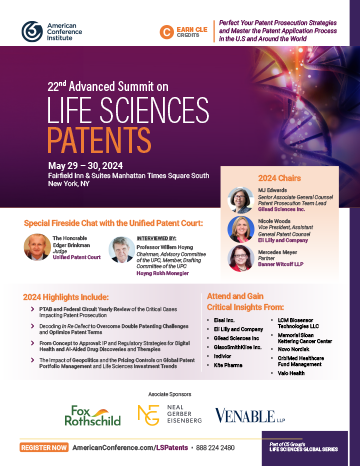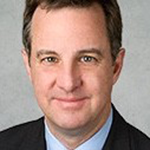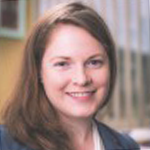Agenda

Flip through our conference brochure and discover what’s new this year.
Download Brochure
Day 1
May 29, 2024
Registration and Breakfast
Amgen v. Sanofi One Year Later: Mastering the Art of Claim Balance and Disclosure in Life Sciences Patent Prosecution

Julie Wu, Ph.D.Supervisory Patent Examiner, Immunotherapy and Recombinant AntibodiesU.S. Patent and Trademark Office

Forrester Liddle, Ph.D.Head of IP and Legal R&D (US)Novo Nordisk

Sarah HoosonCounsel, PatentsMerck Sharp & Dohme LLC

Kevin Noonan, Ph.D.Partner | Co-Chair Biotechnology and Pharmaceuticals Practice GroupMcDonnell Boehnen Hulbert & Berghoff LLP

Thomas J. KowalskiPartner | Chair of Life Sciences, Pharmaceuticals and Biotechnology DivisionsDuane Morris LLP
This landmark Supreme Court decision emphasizing the necessity of sufficient enablement in patent claims, particularly for broad, functionallydefined patents, has reshaped the landscape of patent strategy and application in the life sciences. One year after the decision, this session will highlight how the outcome impacts the approach to patent drafting.
Topics of discussion will include:
- Unpacking the USPTO recently released guidance on written description and enablement
- Lessons learned from recent enablement and/or written description cases
- Evaluating the risk of providing more detailed disclosure to obtain broader claims, both towards obtaining the patent and also enforcing the patent later
- Reconsidering filing date strategy
- Addressing the heightened difficulty of complying with the Amgen ruling
for antibodies
- Determining the optimal level of specification to surpass the enablement threshold and also allows for a reasonable amount of experimentation on all of what is claimed, not merely a subset
- Assessing what type of data (e.g., in vitro, pre-clinical) and how much data is needed to surpass the thresholds
- Reconsidering the doctrine of equivalents
The APJ’s Speak on Practice, Policy, and Procedure in Patent Validity Challenges: Key Developments and Strategies for Prosecutors

Honorable Susan MitchellLead Judge, Patent Trial and Appeal BoardU.S. Patent and Trademark Office

Honorable Jacqueline BonillaDeputy Chief Administrative Patent Judge Patent Trial & Appeal Board U.S. Patent and Trademark Office

Honorable Grace ObermannAdministrative Patent Judge Patent Trial & Appeal Board U.S. Patent and Trademark Office

Kevin GeorgekPartnerWhite & Case LLP
In this exclusive interview, the APJs will answer questions touching on:
- Fintiv and the current policy relating to discretionary denials of institution
- How the Judges consider denials (e.g., serial petitions, parallel petitions, 325(b))
- Recent Director Review decisions relevant to discretionary denials
- The new Guidance on obviousness and the new Guidance on written description and enablement, post-Amgen v. Sanofi
- The latest statistics for types of challenges brought and types of patents challenged
- Best practice tips, i.e., what judges find helpful, unhelpful, the secondary considerations
- Expert declarations and the Xerox case
Networking Break
Federal Circuit, District Court, and PTAB Yearly Review: Key Insights for Prosecutors and Litigators

Rachel J. ElsbyPartnerAkin Gump Strauss Hauer & Feld LLP

Erin M. DunstonPartner | Co-Chair
PTABPanitech Schwarze Belisario & Nadel LLP

Jonathan S. CaplanPartner | Co-Chair, IPKramer Levin Naftalis & Frankel LLP
- Considering precedential and other critical cases from the PTAB
- Analyzing the PTAB affirmation rates and other statistics
- Fleshing out the nuances of how much emphasis to place on prior art in the Information Disclosure Statement
- Reviewing key cases from the federal and district courts
- Considering best practices for Markman hearings
- Revisiting the public accessibility standard (for a printed publication to qualify as prior art) following the Federal Circuit’s precedential decision in Weber, Inc. v. Provisur Technologies, Inc.
- Extrapolating key insights and best practices from these cases towards “bullet-proofing” prosecution from future litigation
Networking Lunch
Decoding In Re Cellect for Prosecutors: Optimizing Patent Adjustments and Overcoming Double Patenting in Global Portfolio Management

Kery A. FriesSenior Legal Advisor, Office of Deputy Commissioner for Patent PolicyU.S. Patent and Trademark Office

Joanna T. BrougherCounsel, IP LeadIndivior

Thomas J. Campbell, Jr.PartnerNeal, Gerber & Eisenberg LLP

Thomas L. IrvingSenior PartnerThe Marbury Law Group, PLLC
This session will provide invaluable insights into the recent In Re Cellect case, offering a deep dive into the intricacies of patent term adjustment (PTA), patent term extension (PTE), and obviousness-type double patenting (OTDP) and equipping life sciences IP professionals with the knowledge they need to strategically manage patent portfolios in light of these critical considerations.
- Unpacking Cellect’s arguments in the en banc petition of In re Cellect, LLC, 81 F. 4th 1216 (Fed. Cir. 2023) and the USPTO’s response
- Exploring the equitable purpose of the OTDP doctrine
- Assessing the strategy of putting more eggs in the PTE basket than reliance on PTA
- Emphasizing strategies in drafting claims for first filed and subsequent continuation applications to avoid OTDP concerns
- Maintaining safe harbour of a divisional all the way through versus filing all at once and re-dividing down the line?
- Outlining measures to audit patent portfolios to safeguard against OTDP challenges
Networking Break
Mastering Subject Matter Eligibility (SME) Rejections: Innovative Strategies for Navigating the Morass of SME Jurisprudence in the U.S. and Abroad

Josephine ChangLegal Advisor, Office of Patent Legal AdministrationU.S. Patent and Trademark Office

Peter F. CorlessPartnerFox Rothschild LLP

Jason N. Mock, Ph.DPartnerFoley & Lardner LLP

Nicole WoodsVice President | Assistant General Patent CounselEli Lilly and Company
Under the Alice/Mayo and Myriad framework, life sciences IP practitioners continue to face the challenging interplay between innovation and protection, as patentable subject matter fails to match innovation within life sciences IP. Topics of discussion will include:
- Dissecting the USPTO’s Patent Subject Matter Eligibility Guidance (PEG)
- What if any deference is given by the Federal Circuit to the USPTO’s PEG
- Lessons learned from patent application allowance rates, PTAB affirmance rates, and patentability decisions from the courts, since Myriad
- Exploring recent cases on subject matter eligibility challenges, especially
challenges to gene-therapy, diagnostics, and combination products
- E.g., the REGENXBIO v Sarepta cases; the Realtime Data, LLC case; CareDX Inc., cases.
- Contrasting to the legal landscape of SME in the US to the EU and Asia
- Exploring the subject matter eligibility challenges to gene-therapy related inventions (REGENXBIO v. Sarepta)
- Reviewing the possibility and likelihood of divided infringement and tailoring prosecution strategy to avoid divided infringement
Balancing Innovation and Data Privacy: Navigating Regulatory Frontiers in Digital Health and Therapeutics

Abeba HabtemariamPartnerArnold & Porter Kaye Scholer LLP

Ksenia TakhistovaChief Legal OfficerLCM Biosensor Technologies LLC

Erin GeyganSenior Privacy Counsel, Data Protection LegalJohnson & Johnson

Sara ShantiPartnerSheppard Mullin LLP
In this panel discussion, speakers will dive deep into the evolving landscape surrounding digital health data privacy, a central pillar in the journey from concept to regulatory approval for digital health technologies and digital therapies. The speakers will dissect recent global data updates that attendees cannot afford to overlook and provide strategies for navigating the complex intersection of digital health, data, and IP rights.
- Exploring the digital health and therapies regulatory landscape
- Compiling FDA digital health guidance and Digital Health Policy Navigator
- Considering the nuances of the regulatory landscape for medical devices that incorporate AI or digital technology
- Unpacking the FDA’s final Clinical Decision Support Software Guidance
- Understanding the FDA’s new medical device cybersecurity guidelines
- Appreciating the advancements in the digital health industry:
- Reviewing FDA’s approved list of devices that incorporate AI/ML
- The integration of microelectromechanical systems (MEMS), smart devices and the integration of Internet of Things into drug delivery devices (e.g., smart pills, smart)
- Getting ahead of the complex intersection of privacy and digital health technology or therapeutics
- E.g., compliance with federal, state, and international regulations in the collection of data
- Considering privacy laws not directly tied to health, such as the new Protecting American’s Data from Foreign Adversaries Act and the changes required with respect to info blocking, info sharing, and web tracking
- Exploring the impact these regulations have on innovation within digital health industries
Cocktail Reception
Conference Adjourns
Day 2
May 30, 2024
Registration and Breakfast
Securing IP Rights in AI-Driven Discoveries: From Concept to Commercialization: Overcoming Patent Challenges in the U.S. and EU

Karlheinz SkowronekSupervisory Patent Examiner in BioinformaticsU.S. Patent and Trademark Office

Jennifer BurdmanVP, Chief Counsel Technology & Therapeutics
Chief IP Officer, Deputy General CounselValo Health

Dina BlikshteynPartner | AI Practice Co ChairHaynes & Boone LLP
Artificial intelligence (AI) has the potential to revolutionize the drug discovery process, offering improved efficiency, accuracy, and speed. However, the successful application of AI is dependent on the availability of high-quality data, the addressing of ethical concerns, and the recognition of the limitations – operational and legal – of AI-based approaches. Topics of discussion will include:
- Preparing and prosecuting AI/ML based applications around the world:
- Considering the USPTO’s renewed exploration of the contours of inventorship law with respect to AI generated inventions
- Subject matter eligibility strategies for when the patent examiner treats the application as a software patent
- UK’s IPO guidance on patent applications for AI inventions
- Considering the FDA’s discussion paper on the use of AI/ML in the development of drug & biologic products
- Unpacking the limitations of the current AI methods in drug discovery
- The suitability of the data, and exploring the implications of data bias
- Navigating the black box model for datasets
- Best practices for electronic lab notebooks and other documentation
methods towards clearly delineating the AI versus human input towards
inventorship and inventorship analyses
- Considering the best approach for first to file versus first to invent, and the EPO versus the UK’s IPO
Morning Networking Break
Unified Patent Court (UPC) Strategy, From Filing to Injunctions: The Ins and Outs for Effective Decision-Making in the Unitary Patent System

Andreas von Falck, Ph.D.PartnerHogan Lovells International LLP

Bethan HopewellPartnerPowell Gilbert

Emmanuel GougéPartnerPinsent Masons France LLP
- Extracting filing trends and best practices from the first year of statistics
and granted unitary patents:
- What products, industries, and countries are requesting Ups the most and when are Eps being granted
- Lessons learned from the first UPC injunction hearing and comparing injunctive relief from the UPC to the U.S (e.g., 10x Genomics)
- Navigating license agreements and the right to prosecute patent
applications
- Factors to consider when agreeing a license covering a EP or EU, as licensor and licensee
- Considering which applicant to name first for a patent application with joint owners from different nationalities
- Appreciating how supplemental protection certificates (SPCs) function in
tandem with unitary patents and the UPC and assessing the advantages and
disadvantages of the European Commission’s proposed changes to SPCs
- Learning the best practices for staying on top of annuities
The Interplay of Geopolitics and Patent Law for Enhanced Portfolio Management: Navigating Global Filing and Patent Term Strategy

Roberto RodriguesPartnerLicks Attorneys

Toby Mak, PhDVice-Chair, Asian Practice CommitteeIntellectual Property Owner’s Association

Jennifer Raoul, Ph.D.Senior Counsel | Patent AttorneyBorden Ladner Gervais LLP (Canada)

Mercedes Meyer, Ph.D.PartnerBanner Witcoff LLP
In this session, leading life sciences IP attorneys will unpack the most substantial patent law reformations from around the world in recent years and will candidly discuss how geopolitical factors have influenced portfolio management. Topics of discussion will include:
- Learning the key considerations for creating harmonized applications around the world
- Knowing what to include for Europe, China, and the US
- Understanding China’s divisional practice
- Maximizing global protection while balancing fees and excess claim fees
- Considering the major changes to patent terms in the U.S., China, Canada, and supplementary protection certificates (SPCs) in the EU
- Appreciating cultural and international factors influencing patent law
- The regulation of traditional knowledge in India and Brazil
- International treaties
- Putting a price on geopolitical instability, price controls and government cadence with respect to drug patents
- Considering changes in global prosecution strategy over the past 10 years
- South America, Africa, Russia, and the Middle East – to file or not to file?
Networking Lunch
The Economics of Life Sciences Innovation Part I
The Dollars and Sense of Drug Price Controls and Policies: Understanding the Impact on R&D, Prosecution Strategy, and Portfolio Management

Adam MossoffProfessor of LawAntonin Scalia Law School, George Mason University

Hilary J. LibkaVice President, Associate General Counsel & Chief IP CounselMemorial Sloan Kettering Cancer Center

Donna MeuthAssociate General CounselEisai

MJ EdwardsSenior Associate General Counsel
Patent Prosecution Team LeadGilead Sciences Inc.
This session will explore how the interplay between policy and economics affects the biopharma landscape. Panelists will detail how the latest regulatory and legislative developments are affecting biopharma R&D and commercial strategies, and what the ramifications of these developments mean for bio pharma prosecution and portfolio management. Topics of discussion include:
- An analysis of the key Inflation Reduction Act price control provisions and
march in-rights under the Bayh-Dole Act that pertain to price controls of
biopharma therapies
- Understanding how recent policy changes reshape R&D priorities and patent prosecution strategy
- Addressing continuations and the newly introduced fee structure for patent term extensions
- Considering Medicare drug price negotiation and the potential impact on the economic models for novel therapy development
- Exploring ownership and inventorship over therapies developed with
federal funding
- Exploring the definitions of federal funding and what funding may trigger march-in rights
- Appreciating the drug pricing enforcement priorities of other agencies such as the Federal Trade Commission
- Considering the FTC’s approach to listings in the Orange Book and how this may influence R&D, prosecution, and market exclusivity
Afternoon Networking Break
The Economics of Life Sciences Innovation Part II
Investors’ Roundtable: Understanding Investment Trends, the Value of the FTO, and the Impact of Governmental Price Controls on Life Sciences Investments

Sandip ArgawalaManaging DirectorBlue Owl Capital

Earl “Eb” BrightPresidentExploraMed

Matthew S. RizzoGeneral PartnerOrbiMed

Monal MehtaManaging Director, Private Investment TeamAvidity Partners

Michael M. ShihVice-President, Corporate DevelopmentKite Pharma
In this special roundtable, life sciences investors will dive deep into the current biopharma investment trends and what impact, if any, the governmental price controls have on patent and product value. Topics of discussion will include:
- Identifying areas of significant M&A activity and emerging investment opportunities in life sciences IP
- Demystifying investor risk assessment, preferences and their target areas for investment or acquisition
- How do investors value and use the freedom-to-operate analysis?
- What financial valuation methods do investors use?
- Considering strategic alliances and royalty monetization
- Examining the unique challenges faced by biotech and AI-aided companies in securing funding
- What value does the FTO create in light of increased reliance on trade secrets by the tech and AI industries?
- Appreciating how investors are considering the impact of the price control provisions on IP under Inflation Reduction Act and the potential of march-in rights under the Bayh-Dole Act in today’s deal-making
- How are price controls, federal funding and patents linked?
- Outlining what investors wish inventors knew before coming to the table
- What do investors want to see in patents and IP strategy?
- When is the strength of the patent the bottom line and when do other factors (such as regulatory exclusivity or clinical trial results) prevail?
- How can IP counsel best present their FTO findings?
Synergizing Patent and Regulatory Strategies: Enhancing Profitability and Compliance in the Life Sciences

Marcus A. ColucciSpecial CounselKramer Levin Naftalis & Frankel LLP

Cynthia MartinAssistant General Counsel, PatentsGlaxoSmithKline Inc.

Yeon Jae Ko, Ph.D.CounselVenable LLP

Erica NoreySenior Counsel, Business Development and M&ASanofi
This session will detail the strategic integration of patent prosecution and regulatory compliance – highlighting the benefits of collaboration between USPTO and FDA. This synergy, driven by USPTO’s duty to disclose, ensures compliance while enhancing profitability via smarter patent drafting. Topics of discussion will include:
- Appreciating the evolution of USPTO-FDA Collaboration
- Taking stock of the evolving partnership and understanding the impact on patent prosecution and regulatory approvals
- Lessons learned from duty of candour cases such as Belcher v Hospira
- Exploring the considerations and best strategies to align prosecution and regulatory strategy at specific phases:
- Early stage
- Clinical
- Approval and commercial launch
- Pre-ANDA investigation and early litigation
- Expiration of regulatory exclusivity
- Litigation, IPRs and PGRs
- Considering the synergy of prosecution and regulatory from the due diligence perspective


